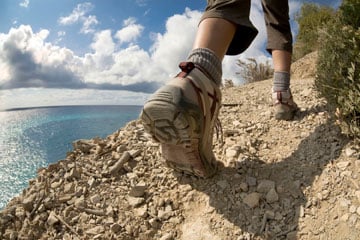EarthTalk®
E – The Environmental Magazine
Dear EarthTalk: What exactly is the federal government’s Recreational Trails Program and is it true that it’s on the chopping block? — Randy Caldwell, Lyme, NH
The Recreational Trails Program (RTP) is a federal assistance program that helps states pay for the development and maintenance of recreational trails and trail-related facilities for both non-motorized and motorized recreational trail uses. The Congressionally mandated program was in jeopardy due to budget cuts, but its backers in Congress announced this past July that RTP would be retained to the tune of $85 million per year as part of the new surface transportation agreement law called MAP-21. Minnesota Democratic Senator Amy Klobuchar was instrumental in the retention of RTP by introducing it as an amendment to MAP-21 as a stand-alone program with its own dedicated funding.
Overall, MAP-21 allocates $105 billion for fiscal years 2013 and 2014 to improve safety, reduce traffic congestion, maintain infrastructure and improve the overall efficiency of highway transportation. RTP is one of several provisions of MAP-21 that bolster transit, bike and pedestrian programs across the country.
Funding for the RTP portion of MAP-21 comes from a portion of the motor fuel excise tax collected across the country from non-highway recreational fuel use in snowmobiles, all-terrain vehicles, off-highway motorcycles and off-highway light trucks, and comes out of the Federal Highway Trust Fund. Half of the RTP funds are distributed equally among all 50 states, and half are distributed in proportion to the estimated amount of non-highway recreational fuel use in each state. Individual states are responsible for administering their own RTP monies and soliciting and selecting qualifying projects.
That said, the use of RTP funding is restricted to maintenance and restoration of existing trails, development and rehabilitation of trailside and trailhead facilities and trail linkages, purchase and lease of trail construction and maintenance equipment, construction of new trails, acquisition of easements or property for trails, and assessment of trail conditions for accessibility and maintenance. RTP funding may not go toward property condemnation (eminent domain), construction of new trails for motorized use on federally managed public lands or for facilitating motorized access on otherwise non-motorized trails.
States must allocate 30 percent of their RTP funding for motorized trail use, 30 percent for non-motorized use, and the remaining 40 percent for so-called “diverse” (motorized and non-motorized) trail use. Projects may satisfy two categories at the same time, giving states some flexibility in how to allocate their share of the RTP pie. States can use up to five percent of their funds to disseminate related publications and operate educational programs to promote safety and environmental protection related to trails.
Trail lovers across the country are thrilled that Congress extended RTP, which began in 2005 with a $60 million allocation and was increased each of the following years until it plateaued at $85 million in 2009. The continuation of the $85 million allocation was also good news to those who feared that if it wasn’t cut entirely it would be scaled back significantly. With new funding for the next two years, Americans can look forward to the creation of many new trails and continued maintenance of existing ones.
CONTACTS: RTP info, www.fhwa.dot.gov/environment/recreational_trails/index.cfm; American Trails overview of RTP funding, www.americantrails.org/rtp.
EarthTalk® is written and edited by Roddy Scheer and Doug Moss and is a registered trademark of E – The Environmental Magazine ( www.emagazine.com). Send questions to: [email protected]. Subscribe: www.emagazine.com/subscribe. Free Trial Issue: www.emagazine.com/trial.








